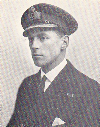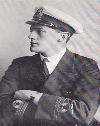



History - World War I (6)

just under and into the middle of the There seemed to be ten Albatrosses against six Nieuport and six S.E.5s and us three Triplanes, split arsing, dodging collisions, finding out who’s who and firing when the chance came. I peeled off right, saw McCrudden dive left, and I took after the last Hun. Booker went straight at the first he could get at, and as I turned back saw he had fastened on a black Hun which was going down with full engine on and smoke spewing out of the cockpit obviously on fire. Good old Bookie. There were two machines under Booker’s tail; as I shook off my first chap I could only make the last one on Booke r and drove him off. Not watching the Hun on fire I did not see him crash, but Bookie himself was flopping about now and at almost ground height I saw him spread out near Parbus, which Jerry started to shell at once. The air was now clear of machines and we had left 13,000 feet to a few hundred in no time.” On October 27th 1917 Squadron Commander Bromet was posted back to his old command at Guston Road, Dover, and
r and drove him off. Not watching the Hun on fire I did not see him crash, but Bookie himself was flopping about now and at almost ground height I saw him spread out near Parbus, which Jerry started to shell at once. The air was now clear of machines and we had left 13,000 feet to a few hundred in no time.” On October 27th 1917 Squadron Commander Bromet was posted back to his old command at Guston Road, Dover, and


promo ted to Wing-Commander. He had led the Squadron through the first half of the war and during that time built up such an esprit de corps and professional ability that Captain Lambe was able to say to Sqn Cdr Draper, the new Squadron Commander: “I’m sending you to No. 8 Squadron - it is my best Squadron.” At the time Sqn-Cdr. Draper took over, the Squadron was specialising in “interference” against enemy machines spotting for their artillery overhead the lines. In order to succeed in the role of spotter, pilots had to remain airborne above the lines all the time the guns were firing, in order to make observations. By setting up Compass Stations along the front with a land line to the Squadron, aircraft could be alerted to drive off the observers overhead. The Squadron was remarkably successful at this job; the Army put the success rate at 35 per cent. Sqn. Cdr. Draper was very pleased and complimented to be told by the RFC. Wing-Commander under whose orders he came: “Draper, I’m not going to give you any more of the usual daily operation orders for Patrols, you will have a free hand to operate exactly as you like”. The Squadron remained at St. Eloi until March, 1918 and was then sent home to Walmer in Kent for a well-earned rest. Naval Eight had been at war alongside the RFC. in the field since October, 1916 except for three weeks re-equipment time spent at Dunkirk. Unfortunately an early re-call to duty was made as the Hun started the Spring Offensive. The Squadron transferred to La Gorgue where it began
ted to Wing-Commander. He had led the Squadron through the first half of the war and during that time built up such an esprit de corps and professional ability that Captain Lambe was able to say to Sqn Cdr Draper, the new Squadron Commander: “I’m sending you to No. 8 Squadron - it is my best Squadron.” At the time Sqn-Cdr. Draper took over, the Squadron was specialising in “interference” against enemy machines spotting for their artillery overhead the lines. In order to succeed in the role of spotter, pilots had to remain airborne above the lines all the time the guns were firing, in order to make observations. By setting up Compass Stations along the front with a land line to the Squadron, aircraft could be alerted to drive off the observers overhead. The Squadron was remarkably successful at this job; the Army put the success rate at 35 per cent. Sqn. Cdr. Draper was very pleased and complimented to be told by the RFC. Wing-Commander under whose orders he came: “Draper, I’m not going to give you any more of the usual daily operation orders for Patrols, you will have a free hand to operate exactly as you like”. The Squadron remained at St. Eloi until March, 1918 and was then sent home to Walmer in Kent for a well-earned rest. Naval Eight had been at war alongside the RFC. in the field since October, 1916 except for three weeks re-equipment time spent at Dunkirk. Unfortunately an early re-call to duty was made as the Hun started the Spring Offensive. The Squadron transferred to La Gorgue where it began































